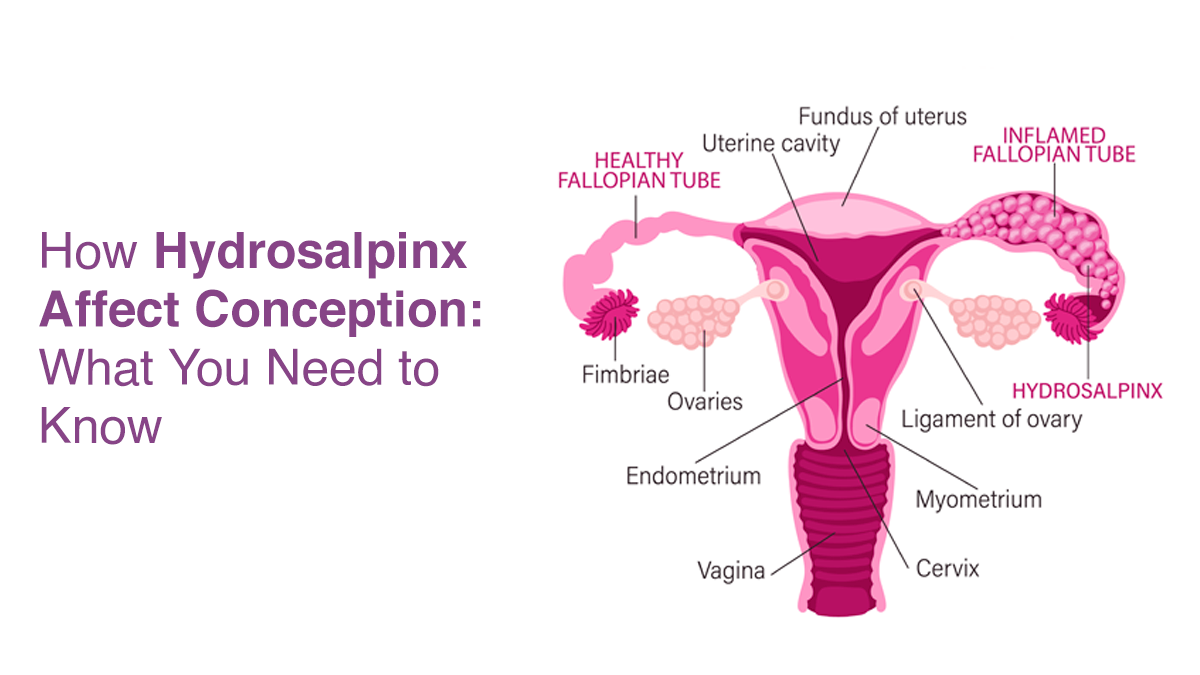
How Hydrosalpinx Affects Conception: What You Need to Know

As you begin trying to get pregnant, you will become familiar with everything that affects fertility – hormones, lifestyle choices, etc. However, the source of the problem is often even more fundamental and resides in the body’s structures. The fallopian tubes are crucial for natural conception, as they serve as the bridge connecting the ovaries and uterus. If something goes wrong with the tubes, then you may be unsuccessful in getting pregnant without ever knowing this is the source of your problem. One such issue is hydrosalpinx – a lesser-known but potentially bigger obstacle for infertility for many women, often with no signs or symptoms.
What is Hydrosalpinx?
In simple terms, hydrosalpinx occurs when one or both fallopian tubes become blocked and fill with a watery fluid. These tubes typically carry the egg from the ovary to the uterus. When they are swollen and filled with fluid, they can’t really do that anymore. Think of it as a roadblock in your body preventing the egg and sperm from meeting. That makes it much more difficult to conceive naturally. Hydrosalpinx itself may not cause a lot of symptoms early on, which is why many women don’t find out about it until they are trying to conceive and undergo fertility testing.
How Hydrosalpinx Develops
Hydrosalpinx usually develops after an infection like pelvic inflammatory disease (PID), a prior surgery, or sexually transmitted infections like chlamydia. Due to the infection causing inflammation, the fallopian tube will have swelling and fluid develops. Over time, the ends of the tube may close and trap some fluid in the tube. The obstruction will block the egg from meeting with the sperm, totally disrupting the fertilization process.
Impact of Hydrosalpinx on Fertility
One of the major effects of hydrosalpinx is reduced fertility. The fluid inside the blocked tube can leak into the uterus and interfere with embryo implantation. Even if an egg is fertilized, this toxic fluid can prevent it from sticking to the uterine lining. Additionally, the blockage stops sperm from reaching the egg in the first place. This is why many women with hydrosalpinx struggle to get pregnant naturally.
How Hydrosalpinx Affects the Fallopian Tubes and Conception
The fallopian tubes are essential for natural conception. They act as the meeting place for the egg and sperm. In hydrosalpinx, this path is blocked or damaged. The inflammation can also alter the lining of the tube, which can harm the egg or embryo. Moreover, the toxic fluid trapped inside the tube may enter the uterus, making the environment less friendly for a baby to grow. These combined factors severely lower the chance of pregnancy without medical help.
Diagnosing Hydrosalpinx: Tests and Imaging Techniques
If you’re trying to conceive and facing challenges, your doctor may recommend a hydrosalpinx test. Common diagnostic methods include:
- Ultrasound: Sometimes a swollen tube can be spotted.
- Hysterosalpingogram (HSG): A special X-ray where dye is inserted into the uterus and fallopian tubes to check for blockages.
- Sonohysterography: Uses sound waves and fluid to look at the uterus and fallopian tubes.
- Laparoscopy: A small surgical procedure to view your reproductive organs directly.
The hydrosalpinx test helps determine the severity of the blockage and guides the next steps.
Treatment Options for Hydrosalpinx and Their Effectiveness
Treatment for hydrosalpinx depends on your fertility goals and how badly the tubes are affected. Here are some options:
- Surgery: Tubal surgery can remove the affected part or open the blockage. In some cases, the entire tube may be removed.
- Antibiotics: If caused by an infection, antibiotics may be used to treat the source.
- Salpingectomy: This is the removal of the damaged tube. It’s often done before IVF treatment to improve success rates.
- Drainage: Sometimes, doctors temporarily drain the fluid, but this is not a long-term solution.
Hydrosalpinx and IVF: What You Need to Know
Many women with hydrosalpinx turn to IVF (In Vitro Fertilization) for a chance at pregnancy. In this process, the egg and sperm are combined outside the body, and the embryo is placed directly into the uterus. However, the effects of hydrosalpinx can reduce the success of IVF treatment.
Studies show that women with untreated hydrosalpinx have lower IVF success rates. That’s why doctors often recommend removing or clipping the tube before starting IVF. Once the source of the toxic fluid is removed, the chances of successful implantation go up.
Can Hydrosalpinx Be Prevented?
You might wonder, can hydrosalpinx be prevented? While not all cases can be avoided, some steps can reduce your risk:
- Practice safe sex to avoid sexually transmitted infections.
- Get early treatment for pelvic infections.
- Follow up after any abdominal or pelvic surgery.
- Go for regular gynaecological check-ups.
Early detection and timely action can prevent complications from worsening.
Coping with Hydrosalpinx and Infertility
Being diagnosed with hydrosalpinx can feel overwhelming. It’s natural to feel frustrated or sad, especially if you’ve been trying to conceive for a while. But you’re not alone. Many women go through similar experiences and still become mothers, sometimes through IVF treatment, and sometimes after successful surgery.
Emotional support, counselling, or joining a fertility support group can help you cope. Stay informed, talk to your doctor, and remember—there is hope.
Conclusion
Hydrosalpinx is a serious condition that can stand in the way of your dream to conceive naturally. Understanding the meaning of hydrosalpinx, its impact, and your treatment options is the first step in taking control of your fertility journey. Thanks to advances in fertility care like IVF and IUI treatment, many women with hydrosalpinx still go on to have healthy pregnancies. To understand more, head over to Oasis Fertility Clinic near you. You can also call us on 1800-3001-1000 or use our live chat option for immediate assistance.
FAQs for Hydrosalpinx
Can you get pregnant naturally after hydrosalpinx?
It’s possible, but the chances are low unless the blockage is mild or surgically treated.
Can hydrosalpinx cause implantation failure?
Yes, the fluid from the tube can interfere with embryo implantation in the uterus.
What are the signs of hydrosalpinx on ultrasound?
A swollen, fluid-filled tube may appear as a dark, elongated structure near the ovary.


fill up the form to get a
Free Consultation
Avail 0% interest on EMI
All Procedures | No Upper Limit
How we reviewed this article:
- Current Version






